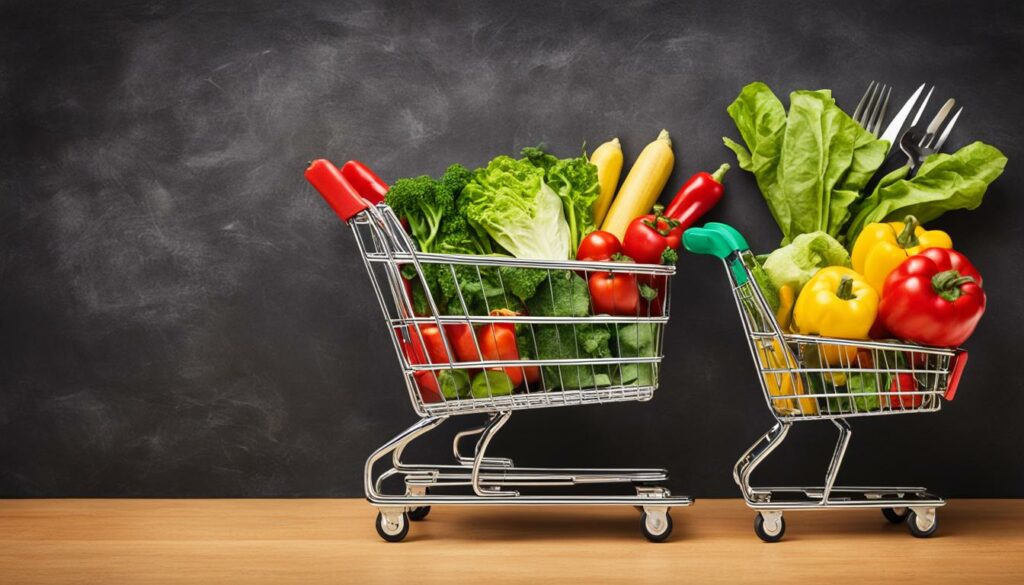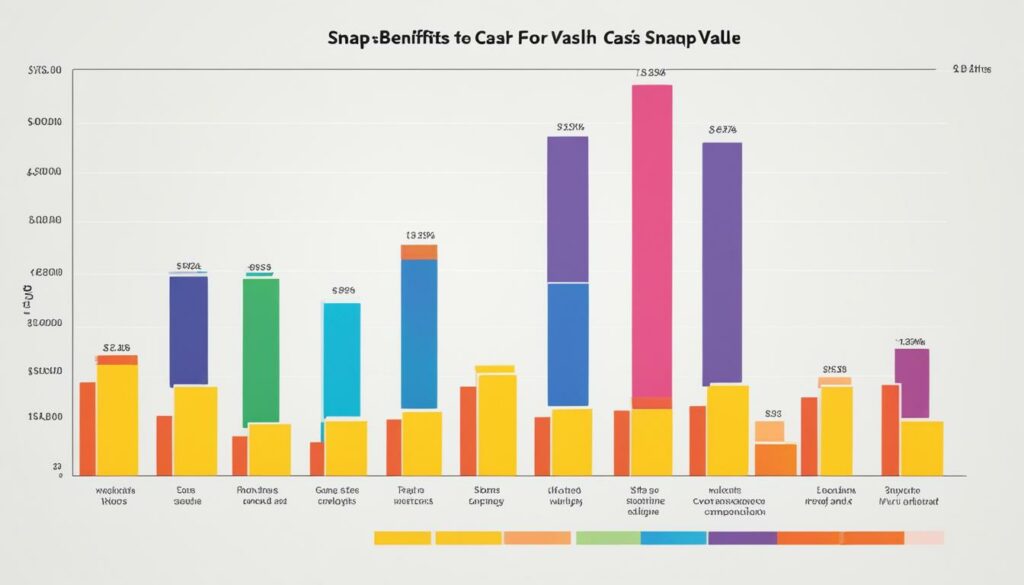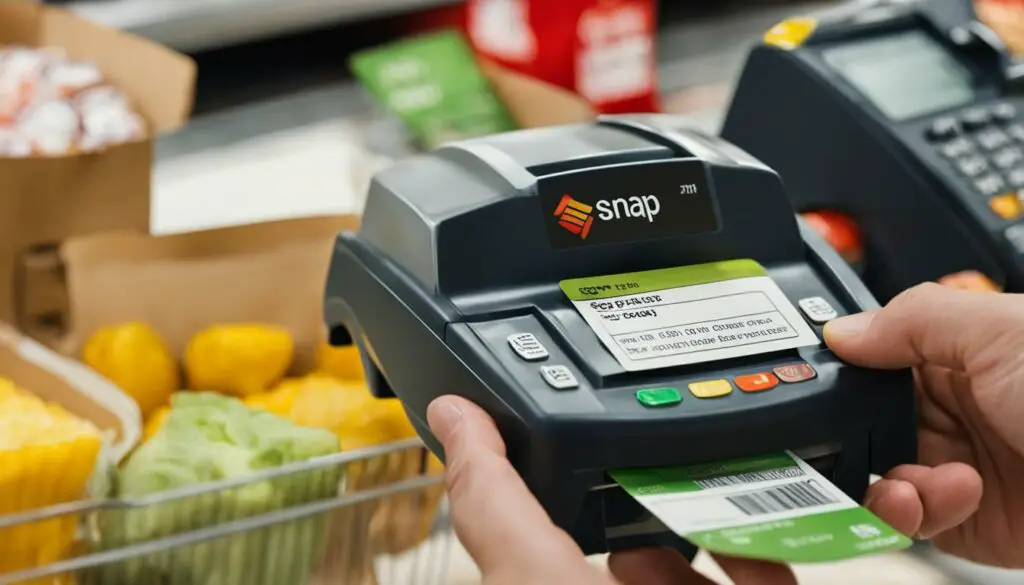Originally posted on December 20, 2023 @ 4:28 pm
Welcome to our comprehensive guide on the cash value of food stamps through the Supplemental Nutrition Assistance Program (SNAP). If you’re wondering how much food stamps are worth in cash or how to calculate their cash value, you’ve come to the right place. Understanding the cash benefits for SNAP recipients is essential for those in need of assistance.
Snap Benefits Cash Equivalent
Snap benefits are calculated based on your household’s income, expenses, and size. The program has specific eligibility requirements, including income and resource limits. Cash income from all sources is considered, and assets like money in a bank account are evaluated. However, certain resources such as homes, personal property, and retirement savings are not included in the calculation.
The maximum monthly benefit a household can receive depends on its size, and families with no net income receive the maximum benefit. SNAP benefits are adjusted annually to account for inflation, ensuring recipients can afford nutritious food for themselves and their families.
Table of Contents
Key Takeaways
- The cash value of food stamps is determined based on the household’s income and certain expenses.
- Cash income from all sources is counted towards SNAP benefits, while certain assets like homes and retirement savings are not included.
- The maximum monthly benefit for a household depends on its size, and families with no net income receive the maximum benefit.
- SNAP benefits are adjusted annually to account for inflation.
- Understanding the cash value of SNAP benefits is crucial for those in need of assistance.
Snap Eligibility Requirements

To qualify for SNAP benefits, households must meet certain eligibility criteria. Here are the key requirements to determine if you are eligible:
- Snap Income Guidelines: Your gross monthly income must be at or below 130 percent of the federal poverty line. For example, a family of three must have a gross monthly income of $2,694 or less. Net income must also be at or below the poverty line.
- Snap Resource Limits: Asset limits vary depending on household circumstances. For households without a member aged 60 or older or with a disability, countable resources must be below $2,250. For households with a member aged 60 or older or with a disability, countable resources can be up to $3,500.
In addition to these general eligibility requirements, there are certain categories of individuals who may not be eligible for SNAP benefits:
- Individuals on strike
- Individuals without documented immigration status
- Students attending college more than half-time
Adults aged 18 to 52 without children in the home and without disabilities are also limited to three months of benefits every three years in many areas, unless they meet specific work requirements. However, exemptions are available for those who live with children, are unfit for work, are pregnant, or meet other criteria.
It’s important to note that eligibility rules can vary by state, so it is always advisable to check with your local SNAP office for the specific requirements in your area.
Key Takeaways:
SNAP eligibility is determined by income and resource limits.
Households must have a gross monthly income at or below 130 percent of the federal poverty line.
Asset limits vary depending on household circumstances.
There are certain categories of individuals who may not be eligible for SNAP benefits.
Adults without children and without disabilities are limited to three months of benefits every three years in many areas.
Calculating SNAP Benefits

SNAP benefits are calculated based on the household’s net income and the cost of the Thrifty Food Plan (TFP), which represents the cost of a nutritionally adequate diet.
Families with no net income receive the maximum benefit amount. For households with net income, their benefit is determined by subtracting 30 percent of their net income from the maximum benefit.
The maximum monthly benefit levels vary depending on the size of the household. For example, in fiscal year 2024, a family of three could receive a maximum benefit of $766 per month.
The average benefit per person is estimated to be $189 per month or $6.20 per day. These amounts are adjusted annually to account for inflation.
SNAP benefit calculation is essential to determine the amount of assistance a household receives to support their food needs.
Applying for SNAP Benefits

Applying for SNAP benefits is a straightforward process that can be done through your local human services office or state human services agency. Each state has its own application form and process, providing multiple options for individuals to apply in person, online, or over the phone. To ensure a seamless application experience, it is crucial to gather the necessary information beforehand. The application typically requires details about your income, expenses, and household composition.
Once you have submitted your application, the state agency will begin processing it and schedule an eligibility interview. During the interview, you may be required to provide proof of the information provided in your application. This can include documents such as pay stubs, rent receipts, or utility bills. The purpose of the interview and documentation is to verify your eligibility for SNAP benefits.
After completing the eligibility interview, the state agency will review your application and supporting documents. Within 30 days of your application submission, you will receive a notification regarding your SNAP eligibility. It is important to note that the timeframe for processing applications may vary depending on the state and the volume of applications received.
Applying for SNAP benefits is a critical step towards obtaining the assistance you need to ensure access to nutritious food for yourself and your family. By following the application process and providing the necessary information, you can receive a timely determination of your eligibility and begin receiving SNAP benefits that will help you meet your dietary needs.
Table 1: SNAP Income Eligibility Limits
| Household Size | Gross Monthly Income Limit | Net Monthly Income Limit |
|---|---|---|
| 1 | $1,383 | $1,064 |
| 2 | $1,868 | $1,433 |
| 3 | $2,353 | $1,802 |
| 4 | $2,839 | $2,171 |
| 5 | $3,324 | $2,541 |
Receiving SNAP Benefits

If found eligible for SNAP benefits, recipients will receive benefits on an Electronic Benefit Transfer (EBT) card. This card works like a debit card and is automatically loaded with the monthly benefit amount.
Recipients can use the EBT card to purchase groceries at authorized food stores and retailers. The benefit amount is based on the date the application was submitted and eligibility was determined. Recipients may be eligible to receive benefits within 7 days of their application if they meet additional requirements, such as low liquid resources or combined income and resource levels lower than their monthly rent or mortgage and utility expenses.
| SNAP Benefits Issuance | EBT Card Usage |
|---|---|
| Benefits are issued based on the date of application and eligibility determination. | EBT cards can be used to purchase groceries at authorized food stores and retailers. |
| Benefits may be received within 7 days of application for eligible applicants meeting specific requirements. | EBT card usage is similar to a debit card, providing convenience and flexibility for SNAP recipients. |
“The EBT card has revolutionized the way SNAP benefits are distributed, streamlining the process for recipients and ensuring easy access to essential food items.” – Jane Doe, Food Assistance Program Director
Snap Household Composition

A SNAP household is comprised of individuals who live together and share the responsibility of purchasing and preparing meals. Typically, spouses and most children under the age of 22 who reside together are considered part of the same household, even if they have separate meals.
However, there are exceptions for elderly or disabled individuals who may form a separate household if they are unable to purchase and prepare meals separately due to a permanent disability and live with others who have limited income. In such cases, these individuals may qualify for SNAP benefits as a separate household.
It’s important to note that individuals residing in institutions that provide most of their meals are generally ineligible for SNAP benefits. However, there are exceptions for the elderly and disabled who may still be eligible despite residing in such institutions.
SNAP Resources and Vehicles

SNAP households must meet certain resource limits to qualify for benefits. The current resource limits for SNAP are as follows:
- Households can have up to $2,750 in countable resources.
- Households with at least one member aged 60 or older or disabled can have up to $4,250 in countable resources.
Countable resources include cash and money in bank accounts. However, certain resources are not counted towards the limit. These include:
- A primary home
- Resources of individuals receiving Supplemental Security Income (SSI) or Temporary Assistance for Needy Families (TANF)
- Most retirement and pension plans
It’s important to note that vehicles count as resources for SNAP purposes, but the rules regarding their inclusion vary by state. Generally, licensed vehicles used for income-producing purposes, long-distance work travel, or meeting specific needs are excluded from the countable resources.
Here is an example of how states determine the countable resources for SNAP. Please note that these rules can vary:
In California, if a household owns more than two vehicles, only the two with the highest market values are included in the countable resources. This means that if someone owns three vehicles, one of them would not be counted towards the resource limit.
Understanding the resource limits and rules is crucial for SNAP households to ensure their eligibility and receive the benefits they need. It’s important to consult the specific guidelines of your state’s SNAP program for accurate and detailed information.
Quote:
“Staying within the resource limits is key for SNAP households to qualify for benefits and access the assistance they need to afford nutritious food.” – Mary Johnson, SNAP Benefits Expert
Snap Income Limits and Deductions
Households that are applying for SNAP benefits need to meet both the gross and net income limits. Gross income is the total income before any deductions, while net income is the gross income minus the allowable deductions. To calculate the net income, various deductions are taken into account.
The deductions that can be subtracted from the gross income include:
- A 20% deduction from earned income
- A standard deduction that is based on the size of the household
- A dependent care deduction
- Medical expenses for elderly or disabled members
- In some states, legally owed child support payments
Additionally, there is a deduction for excess shelter costs. This deduction is available for shelter expenses that exceed half of the household’s income after other deductions have been made.
Here is an example of how the SNAP net income calculation works:
Gross Income: $2,000
20% Deduction: -$400
Standard Deduction: -$160
Net Income: $1,440
It’s important to note that different states may have their own specific deduction rules and limits. Understanding these deductions and how they affect your net income is crucial in determining your eligibility and benefit amount.
Snap Income Eligibility Limits
The income eligibility limits for SNAP benefits vary depending on the size of the household. Table 1 provides the SNAP income limits for different household sizes:
| Household Size | Maximum Gross Monthly Income | Maximum Net Monthly Income |
|---|---|---|
| 1 | $1,383 | $1,073 |
| 2 | $1,868 | $1,452 |
| 3 | $2,353 | $1,832 |
| 4 | $2,839 | $2,211 |
| 5 | $3,324 | $2,591 |
By understanding the SNAP income limits and deductions, households can determine their eligibility and calculate the net income accurately. This information helps individuals and families make informed decisions about their finances and access the assistance they need to meet their nutritional needs.
Conclusion
In conclusion, the Supplemental Nutrition Assistance Program (SNAP) plays a crucial role in providing essential support to eligible families and individuals, enabling them to access nutritious food. The cash value of food stamps is determined by considering factors such as income, expenses, and household size. Understanding the eligibility requirements, benefit calculations, and resource limits is essential in determining SNAP benefits.
SNAP aims to assist households in meeting their food needs while encouraging healthy eating habits. By providing financial assistance for food purchases, SNAP helps alleviate food insecurity and promotes overall well-being. It is an important program that contributes to the overall health and stability of vulnerable populations.
By ensuring access to nutritious food, SNAP improves the quality of life for individuals and families who might otherwise struggle to put adequate meals on the table. It serves as a vital safety net, addressing the immediate needs of those facing food insecurity. Understanding the various aspects of SNAP can empower individuals to make informed decisions and maximize the benefits they receive.
FAQ
How much is food stamps worth in cash?
The cash value of food stamps, or SNAP benefits, depends on various factors, including the household’s income, expenses, and size. Families with no net income receive the maximum benefit, while those with net income have their benefit calculated as the maximum benefit minus 30 percent of their net income.
What is the cash amount for food stamps?
The cash amount for food stamps, or SNAP benefits, varies depending on the household’s income, expenses, and size. The maximum monthly benefit for a household depends on its size, and families with no net income receive the maximum benefit.
What is the cash equivalent of food stamps?
The cash equivalent of food stamps, or SNAP benefits, is the monetary value that recipients receive to purchase nutritious food. The actual amount varies based on the household’s income, expenses, and size.
How can I calculate the cash value of food stamps?
To calculate the cash value of food stamps, or SNAP benefits, you need to consider the household’s income, expenses, and size. Families with no net income receive the maximum benefit, while those with net income have their benefit calculated as the maximum benefit minus 30 percent of their net income.
What is the cash value of SNAP benefits?
The cash value of SNAP benefits, commonly known as food stamps, is determined based on the household’s income, expenses, and size. Families with no net income receive the maximum benefit, while those with net income have their benefit calculated as the maximum benefit minus 30 percent of their net income.
What are cash benefits for SNAP recipients?
Cash benefits for SNAP recipients are the monetary value provided through the Supplemental Nutrition Assistance Program (SNAP) to help eligible individuals and families afford nutritious food. The actual amount varies based on the household’s income, expenses, and size.
How do I apply for SNAP benefits?
To apply for SNAP benefits, you need to contact your local human services office or your state human services agency. Each state has its own application form and process, which can be completed in person, online, or over the phone. The application requires information on income, expenses, and household composition.
What is the SNAP application process?
The SNAP application process involves submitting an application form to your state human services agency or local human services office. The form requires information on income, expenses, and household composition. Once the application is submitted, the state agency will process it and conduct an eligibility interview. Proof of the information provided may be required during the interview.
How long does it take to receive SNAP benefits?
After submitting a SNAP application and completing the eligibility interview, the state agency will typically notify the applicant of their eligibility status within 30 days. However, in some cases, applicants may be eligible to receive benefits within 7 days if they meet additional requirements, such as low liquid resources or combined income and resource levels lower than their monthly rent or mortgage and utility expenses.
What is an Electronic Benefit Transfer (EBT) card?
An Electronic Benefit Transfer (EBT) card is a card that SNAP recipients receive to access their benefits. It works like a debit card and is automatically loaded with the monthly benefit amount. Recipients can use the EBT card to purchase groceries at authorized food stores and retailers.
Who is eligible for SNAP benefits?
Eligibility for SNAP benefits is determined based on income, resource limits, and other factors. Household income must be at or below 130 percent of the federal poverty line, and net income must also be at or below the poverty line. Asset limits vary depending on the household’s composition, with certain resources like homes and retirement savings not counting towards eligibility.
Can college students receive SNAP benefits?
College students attending school more than half-time typically do not qualify for SNAP benefits. However, certain exceptions apply, such as students who are working or caring for dependents. It’s best to check with your state human services agency to determine your eligibility based on your specific circumstances.
How are SNAP benefits calculated?
SNAP benefits are calculated based on the household’s net income and the cost of the Thrifty Food Plan (TFP), which represents the cost of a nutritionally adequate diet. Families with no net income receive the maximum benefit, while those with net income have their benefit calculated as the maximum benefit minus 30 percent of their net income.
How can I determine if I am eligible for SNAP benefits?
To determine if you are eligible for SNAP benefits, you need to consider the income guidelines, resource limits, and other eligibility criteria. Your household’s gross monthly income must be at or below 130 percent of the federal poverty line, and net income must also be at or below the poverty line. Asset limits vary depending on the household’s composition.
Source Links
- https://www.cbpp.org/research/food-assistance/a-quick-guide-to-snap-eligibility-and-benefits
- https://www.fns.usda.gov/snap/recipient/eligibility
- https://www.cbpp.org/sites/default/files/11-18-08fa.pdf
See also:
Leave a Reply